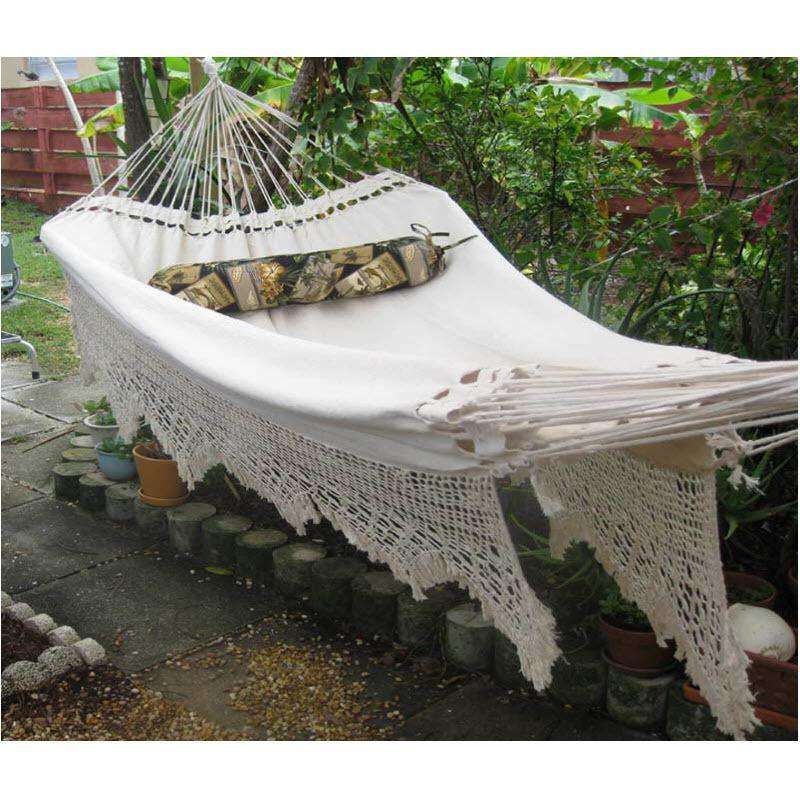In the relaxing world of outdoor living, few things offer such a delightful blend of comfort and simplicity as a hammock swing. But have you ever wondered about the environmental impact of your favourite outdoor retreat? This article will take you on a comprehensive journey to explore how these simple, yet versatile pieces of leisure furniture can affect the world around us.
Hammock swings, an emblem of relaxation and serenity, are much more than just a woven bed hung between two sturdy supports. The reality is that, like every other human-made product, they leave a certain ecological footprint. Understanding this footprint, and how to mitigate it, is crucial for eco-conscious consumers.
The Hammock Swing's Lifespan: From Raw Material to Finished Product
The environmental journey of a hammock swing starts long before it cradles you in your backyard, beginning with the extraction of raw materials.
Depending on the type of hammock, these materials can range from cotton, polyester, and nylon to wood and metal for the supports. Each comes with its own environmental considerations.
Cotton, for instance, is a natural, biodegradable material, but its cultivation can involve heavy pesticide use and significant water consumption. Synthetic fabrics like polyester and nylon, on the other hand, are not biodegradable and their production often involves environmentally harmful chemicals. However, they tend to be more durable, which can mean fewer replacements and less waste in the long run.
The environmental impact of wood and metal supports, too, depends on factors like the sustainability of logging operations, and the energy and resources used in mining and refining processes.
Manufacturing Processes and Energy Consumption
Next, consider the energy consumed during manufacturing. Every step, from the spinning of threads and weaving of fabric to the assembly of the final product, requires power. The source of this power, whether renewable or non-renewable, directly affects the hammock swing's carbon footprint.
Distribution and Transportation
The distribution and transportation phase also adds to the hammock's ecological footprint. Every mile covered to transport these hammocks from factories to warehouses, then to retail stores or directly to your doorstep, results in carbon emissions.
The Local Impact: Hammocks, Trees, and Biodiversity
But the environmental story of hammock swings doesn't end with production and distribution. Once they are installed, these hammocks can also impact local ecosystems, particularly when they are hung from living trees.
Though it might seem harmless, improper hammock hanging can cause damage to tree bark, potentially harming the tree and affecting its role in the ecosystem. However, there are ways to hang hammocks that minimize this risk, like using wide, flat straps instead of thin ropes, and ensuring the hammock isn't hung too tightly.
Path to Sustainability: Eco-friendly Choices and Hammock Care
Thankfully, for those of us who love our hammock swings, there are plenty of ways to enjoy this comfort while minimizing harm to our planet.
Many companies now produce eco-friendly hammocks made from organic cotton, recycled polyester, or responsibly sourced wood. Some even provide 'tree-safe' hanging kits designed to protect tree bark.
Proper hammock care can also go a long way towards reducing its environmental impact. By cleaning and storing your hammock swing correctly, you can extend its lifespan and reduce the need for frequent replacements.
Another way to practice sustainability is by recycling or repurposing your hammock when it reaches the end of its life. Consider turning an old hammock into a picnic blanket or cutting it into cleaning rags. The possibilities are endless!
A Deeper Look: Sustainable Materials
Let's delve a bit deeper into the environmental profile of some commonly used hammock materials.
Cotton
Cotton hammocks are loved for their natural, soft feel and breathable fabric. But as mentioned earlier, conventional cotton farming is a heavy user of water and chemical pesticides. An alternative is organic cotton, which is grown without synthetic pesticides or fertilizers.
But even organic cotton has its downsides, as it still requires a substantial amount of water to grow. That said, it's certainly a step up from conventional cotton in terms of environmental impact.
Polyester and Nylon
These synthetic materials are durable and weather-resistant, making them a popular choice for outdoor hammocks. However, their production involves petroleum, a non-renewable resource, and they are not biodegradable.
On the positive side, there are now hammocks made from recycled polyester, which help to reduce the environmental footprint of these synthetic materials.
Wood and Metal Supports
The sustainability of wood and metal supports hinges largely on sourcing and production methods. For wood, look for hammock stands made from responsibly sourced timber. Check for certifications like the Forest Stewardship Council (FSC), which ensures the wood is harvested in an environmentally friendly and socially responsible manner.
As for metal, while the extraction and refining processes can be energy-intensive and environmentally damaging, metal is highly recyclable. A high-quality metal hammock stand can last for many years, and when it does reach the end of its life, it can often be recycled.
Hammock Swing: A Catalyst for Environmental Awareness
The seemingly simple hammock swing, in reality, weaves a complex narrative of environmental impact that spans continents, cultures, and ecosystems. From the raw materials used in its construction, to the energy consumed in its production and distribution, to its potential impact on local flora and fauna, the hammock swing's environmental story is far-reaching.
However, knowledge is power. By understanding these impacts, we can make informed choices about the hammocks we buy and how we use them. By opting for sustainable materials, prolonging the lifespan of our hammocks, and ensuring we hang and dispose of them responsibly, we can significantly reduce the environmental footprint of our hammock swings.
In a way, hammocks can be seen as a microcosm of our broader relationship with the natural world. They invite us to rest, relax, and enjoy nature, yet they also serve as a reminder of our impact on the environment and our responsibility to care for it.
As we swing in our hammocks, let us ponder on these thoughts and cherish the beauty and tranquility of our surroundings. After all, isn't that the essence of the hammock experience?
So next time you lie back in your hammock swing, remember that you're part of a bigger picture. Every choice you make, every product you buy, leaves a mark on our planet. Let's strive to make it a green one.
Conclusion
The humble hammock swing, so often a symbol of leisure and relaxation, is more than just a comfy place to lounge. Its environmental impact, though complex, is a critical part of its story.
Whether you're a hammock lover or just an environmentally conscious consumer, we hope this article has provided a fresh perspective on this everyday product. It's a potent reminder that we all have a part to play in preserving our planet, even when we're simply deciding where to relax and enjoy a sunny afternoon.
Embracing eco-friendly options, understanding the materials used in our products, and being mindful of how we use and care for our belongings are all ways we can make a positive difference. Every step towards sustainability is a stride towards a healthier, greener planet.
As we swing in the balance, let's make sure our hammocks are swinging the right way for the environment. Happy hammocking!





Comments